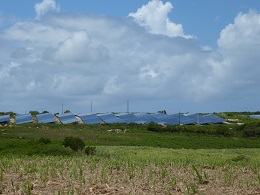08 April 2019
 How much difference can five minutes make? Quite a lot, actually, when it comes to weather forecasting.
How much difference can five minutes make? Quite a lot, actually, when it comes to weather forecasting.
In the case of Australia’s renewable energy sector, inaccurate short-term forecasts relating to wind and solar generation have cost the industry around $5 million in the past decade, according to UniSA Professor of Environmental Mathematics, John Boland.
Cloud cover is partially to blame, playing havoc with accurate forecasts, causing scheduling errors and affecting electrical outputs, but a new $1.2 million project with the UniSA component led by Prof Boland promises to help rectify this.
Over the next 18 months Prof Boland and UniSA researchers will design a world-first, short-term statistical forecasting model to more accurately predict weather conditions from five minutes up to 1-2 hours.
Working alongside colleagues from CSIRO, the University of New South Wales and Genex Power Ltd, Prof Boland hopes to produce an industry-best practice forecast model to ultimately cut power prices and make renewable energy more reliable.
“Accurately forecasting the output of grid-connected solar systems is critical to increasing the overall penetration of solar and renewables. This is important for the stability and management of the electrical system as a whole,” he says.
“Clouds can move and form very quickly, creating complex atmospheric layers which often move in different directions. The existing forecasting systems for wind and solar are designed for longer-term timeframes and have led to multiple issues over the years. This highlights the need for reliable short-term forecasts to provide confidence to both renewable generators and the entire industry.”
The project will implement a short-term solar forecasting system on five operational solar farms spread from far north Queensland to Victoria – all sites experiencing changeable weather conditions.
The researchers will use a range of technologies, including skyward-facing cameras with machine vision algorithms to track and predict cloud motion, satellite imaging, statistical models and power conversion models.
“It is the first time all these forecasting techniques have been combined to help create a single model to more accurately forecast weather,” Prof Boland says.
“This will be a world first and will represent an international benchmark for short-term solar power forecasting.”
Prof Boland says the industry gains will be substantial, reducing both grid instability and costs.“By producing forecasts that are more aligned to the actual solar output, renewable energy generators will no longer be unfairly penalised and the benefits will be passed on to consumers,” he says.
Australia leads the world in household solar power, with around 15 per cent of the nation’s roofs now fitted with PV panels, lowering energy costs and reducing our reliance on fossil fuels.
The project received funding from ARENA as part of its Advancing Renewables Program.
……………………………………………………………………………………………………………
Media contact: Candy Gibson office (08) 8302 0961mobile:0434 605 142
email: candy.gibson@unisa.edu.au
Lead researcher: Professor John Boland office (08) 8302 3449 mobile: 0424 030 093
email: john.boland@unisa.edu.au
…………………………………………………………………………………………………………………………



